![]()
|
|
|
|
|
Stoke-on-Trent - Potworks of the week |
Advert of the Week
Photo of the Week
Samuel Alcock's Hill Pottery, Westport Road, Burslem
|
This part of Burslem was know as 'The Hill' for centuries - a 1750 map shows 'Hill Meadow', 'The Hill', 'Hill Top', 'Taylor's Hill'.
Confused? There were the Hill Works of the Riley brothers and the Hill Pottery built by Alcock - they were on opposite corners of a road junction. The names of the pottery factories was used interchangably by some and so the Alcock's factory would also be called the Hill Works (as was the Riley factory). Additionally both factories had a number of sucessive occupiers who all traded under different names. To add to the confusion the Alcock's works was later divided into china and earthenware sections. Sometimes there were more than one company operating from the works at the same time. |
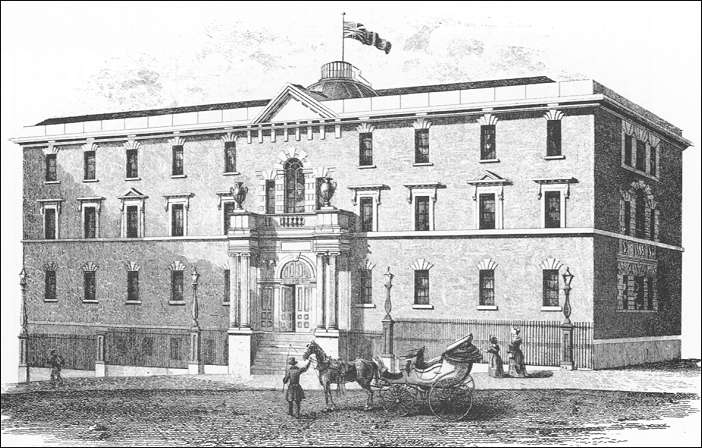
Hill Pottery, Westport Road,
Burslem
built on the corner of Westport Road and Greenhead Street on site of
previous works
- originally Westport Road was called Liverpool Road, it was renammed in the
1950's -
the old works were rebuilt by
Samuel Alcock in 1839 and described at the
time as 'the most striking and ornamental object of its kind
within the precincts of the borough'
|
"The Hill Pottery of 1839 was designed by Thomas Stanley, a Shelton architect, who also designed St.John's Church and school in Goldenhill and St. Thomas's church in Mow Cop. The street range of the works had the by now traditional Venetian window and pediment over. There, however, the similarities ended; the façade being far more ornate than those of any of its predecessors, the decoration was designed to focus attention on the near central entrance bay.
The entrance itself took the form of a tripartite opening, echoing the Venetian window above. In contrast, the treatment of the bays to either side of the entrance was relatively restrained, ornamentation being restricted to the chamfered stone voussoirs of the ground and second-floor windows, and the hood moulds of the first-floor windows." from: 'Potworks, the Industrial Architecture of the Staffordshire Potteries' |
|
Scrivens (Government Inspector) report on Alcock's works in 1842:
|
testimony of the workers in 1842......
|
Messrs. ALLCOCKS' Earthenware and China Factories, Burslem. |
|
|
|
|
|
No. 191.- Sus. Wilcox, |
aged 10 |
|
I am an apprentice to Mr. Allcock, as a burnisher. Have been bound 12 months. There are three apprentices, and 30 or 40 young women working in the same room with me ; the three are under 13 years ; most all the women served their time here. We have no men or boys in the same room with us. There are three superintendents looking over us; they are very kind to me sometimes: sometimes they give me a slap upon the back when I look off; my work ; that is all the punishment I get, except a scolding. I never forfeit pay for breakages. I get rewarded sometimes with a penny, when I'm a good girl; the burnishers give it, not the master. I get 1s, or 1s. 6d. a week, and carry it home to mother. She stays at home to look after the children : she has five. I can read and write a bit; not much. I go to Sunday school ; went to a day school afore I came. I like my work very well, and should not like to leave it. |
|
|
Messrs. ALLCOCKS' Earthenware and China Factories, Burslem. |
|
|
|
|
|
No. 192.-Hannah Rogers, |
aged 12 |
|
I am an apprentice to the company as a burnisher; have served one year; we are bound for six. I ought to come in the morning at six, to sweep out, but sometimes come as late as seven; then I have to pay 2d. to another. We do this work in turns, 20 of us. I go home at different times; it depends upon what I have to do. I don't know how much work I do; but when there's plenty I carry home 2s. Saturday nights: I give it to mother; she stays at home. Father is a gilder, and works here. I have one brother and three sisters. I can read, but cannot write : my brother can read, my sisters cannot. I go to chapel school twice a day. |
|
|
Messrs. ALLCOCKS' Earthenware and China Factories, Burslem. |
|
|
|
|
|
No. 193. Mary Nixon, |
aged 11 |
|
I am a paper cutter for Mary Sergeant; she is employed by Samuel Sergeant, the printer, who is her husband. We have two pressmen, two girls, and four women working with me in the same room. I have been to work three weeks next Tuesday. Can read, but cannot write. Went to day school at Mrs. Williams's; go every Sunday to Baptist school. I come to work at half-past six ; get my dinner in the same room in which I work ; never hear bad language there ; never hear swearing I go home at six o'clock, or half-past. Work Mondays, when there is work to do. Did not work last Monday. Samuel Sergeant is a very good man. I get now 2s. a week; shall have 3s. soon. I always take it home for my mother. My father is a slip-maker; mother stops at home to look after the young ones. Have two sisters and one brother; one of my sisters is older than I am; she is a transferer. |
|
|
Samuel Alcock (b.1799 – d.1848) was a leading pottery manufacturer based in Burslem - though from a farming background, he developed an interest in commerce after working with his uncle Joseph Locker, a grocer and banker of the Market Square, Hanley.
In 1836, Alcock was appointed improvement commissioner for Burslem and in 1842 was elected chief constable for the town. In this post he took an important part in quelling the Chartist Riots.
In
November 1848 Samuel Alcock died and his works closed around 1859. |
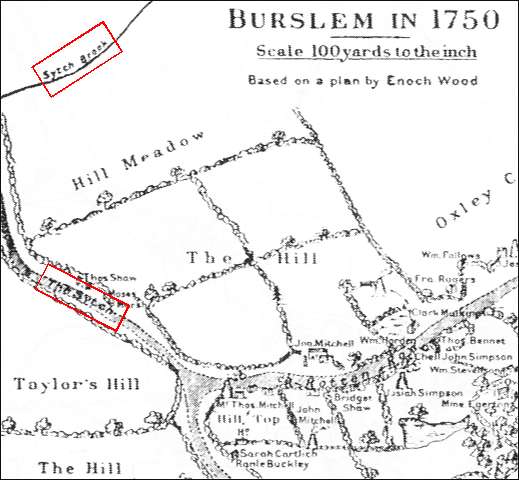
1750 map of the Sytch in
Burslem - showing The Hill area
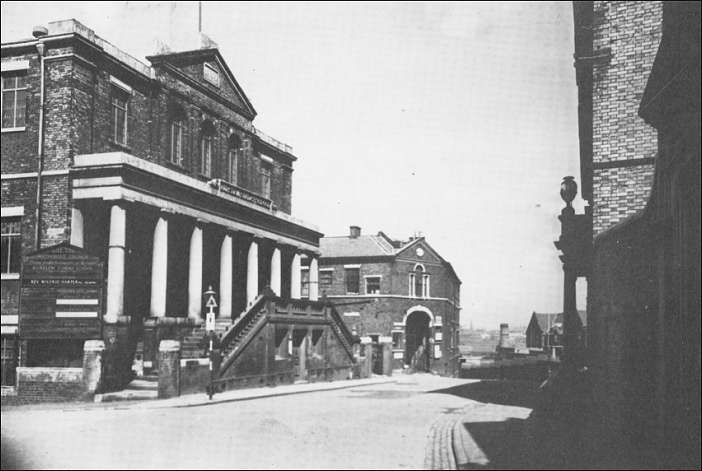
to the far right can just be seen the frontage of the Hill Pottery
to the left is the Burslem Sunday School and in the centre the Hill Works
photo: Warrillow collection
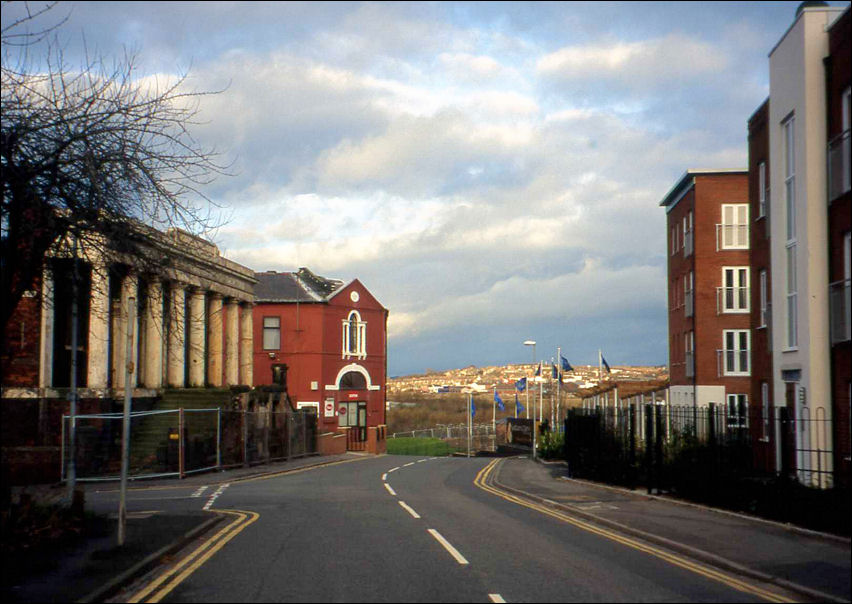
the same location in 2009
flats and houses
occupy the location of Alcock's Hill Pottery and Greenhead Street
following a fire in 1983 only the portico remains of the Sunday School
The Hill Works of 1814 still remains

another view showing the Hill
Pottery (with the car outside),
the Hill Works (to the far left) and the frontage of Burslem Sunday School
![]() see
here for a list of the occupiers of the Hill Pottery
see
here for a list of the occupiers of the Hill Pottery
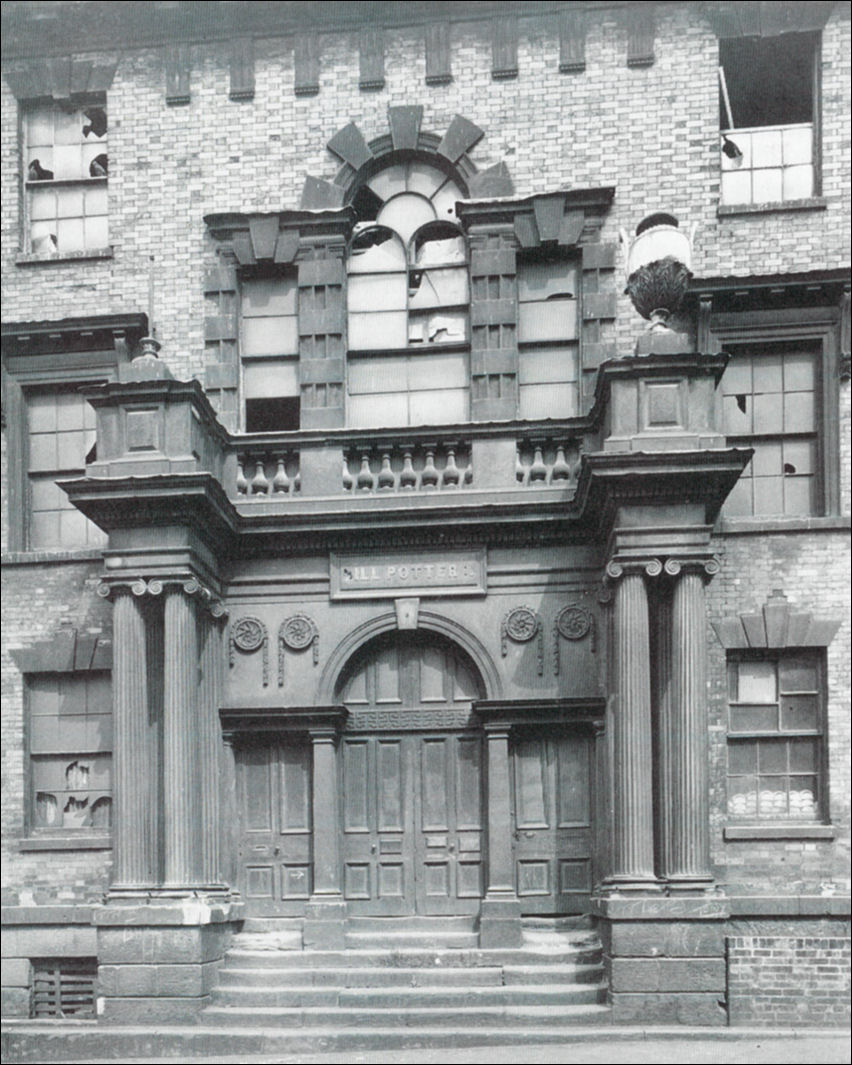
The novelist Arnold Bennett called
the Hill Pottery works "Sytch Pottery" in the Clayhanger book.
detail of the front entrance from "Potworks"
|
this
conversation about the Hill Pottery (Sytch Pottery) is from Arnold
Bennett's novel 'Clayhanger'... "At last!" he murmured with disgust. Then he said: "That's the most beautiful window in Bursley, and perhaps in the Five Towns; and you see what's happening to it."
"Why are they boarding it up, Mr. Orgreave?" Edwin asked. "Oh! Ancient lights! Ancient lights!"
"I should think," said Mr. Orgreave, "I should think they've been at law about that window for thirty years, if not more. Well, it's over now, seemingly." He gazed at the disappearing window. "What a shame!" "It is," said Edwin politely. Mr. Orgreave crossed the road and then stood still to gaze at the façade of the Sytch Pottery. It was a long two-storey building, purest Georgian, of red brick with very elaborate stone facings which contrasted admirably with the austere simplicity of the walls. The porch was lofty, with a majestic flight of steps narrowing to the doors. The ironwork of the basement railings was unusually rich and impressive. "Ever seen another pot-works like that?" demanded Mr. Orgreave, enthusiastically musing. "No," said Edwin. Now that the question was put to him, he never had seen another pot-works like that. "There are one or two pretty fine works in the Five Towns," said Mr. Orgreave. "But there's nothing elsewhere to touch this. I nearly always stop and look at it if I'm passing. Just look at the pointing! The pointing alone..." Edwin had to readjust his ideas. It had never occurred to him to search for anything fine in Bursley. The fact was, he had never opened his eyes at Bursley. Dozens of times he must have passed the Sytch Pottery, and yet not noticed, not suspected, that it differed from any other pot-works: he who dreamed of being an architect! "You don't think much of it?" said Mr. Orgreave, moving on. "People don't."
Clayhanger - Arnold Bennett |
|
Related Pages Scrivens report in 1842 on child labour in the Potteries In 1840 the House of Commons set up a commission to inquire into the state of children employed in the mines and manufactories. Samuel Scriven visited the area of Stoke-on-Trent from December 1840 onwards to collect evidence.
Packhorse
& Turnpikes
Burslem
Sunday School also
see..
Advert of the Week
|